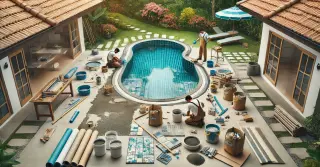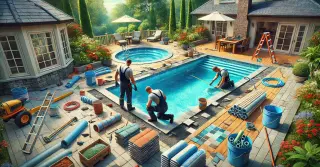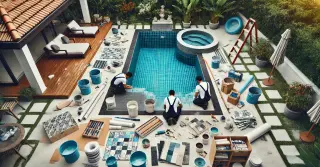Swimming Pool Resurfacing Duluth GA

Swimming pool resurfacing is a critical maintenance task that preserves the integrity of the pool’s structure and appearance. Over time, pool surfaces can become worn, cracked, or discolored, affecting both functionality and appearance. Regular resurfacing ensures the pool remains safe, attractive, and enjoyable.
Picking the Ideal Resurfacing MaterialA critical choice in pool resurfacing is choosing the appropriate material for the job. Different materials provide various advantages, so considering your needs and preferences is important.
- Classic Plaster: Plaster is a traditional material used in resurfacing due to its affordability and durability. It provides a smooth finish and is available in various colors. However, it needs more maintenance over time compared to other materials.
- Pebble Finish: Pebble aggregate finishes provide a natural, textured appearance. They are extremely sturdy and slip-resistant, making them an excellent choice for high-traffic pools. Pebble surfaces are also available in a variety of colors and blends, permitting a custom appearance.
- Quartz: Quartz finishes combine the smoothness of plaster with pebble's durability. They are very stain-resistant and etch-resistant, giving a durable, easy-care finish. Quartz finishes are available in many vibrant colors, adding a touch of elegance to your pool.
Steps in the Pool Resurfacing ProcessResurfacing a pool requires a series of crucial steps to ensure a high-quality result. Knowing these steps can help you prepare for the project.
- Draining and Preparation: The initial step in resurfacing is draining the pool and preparing the surface. This means removing the existing surface material and giving the pool a thorough cleaning to ensure proper adhesion of the new material.
- Applying the New Surface: After preparation is complete, the new surface material is applied. This step needs precision and skill to ensure an even and smooth finish. Professional contractors use specialized tools and techniques to achieve the best results.
- Curing the Surface and Refilling: Once the new surface is in place, proper curing is essential. This includes letting the surface set and harden for a designated time. After the curing process is finished, fresh water is added to the pool, and it’s ready for swimming.
Renovating your pool surface is an important part of pool maintenance. By picking the right materials, knowing the steps, and working with professionals, you can keep your pool looking great, functioning well, and staying safe.




